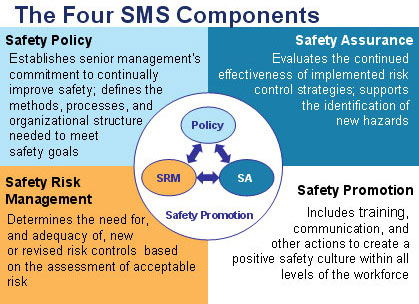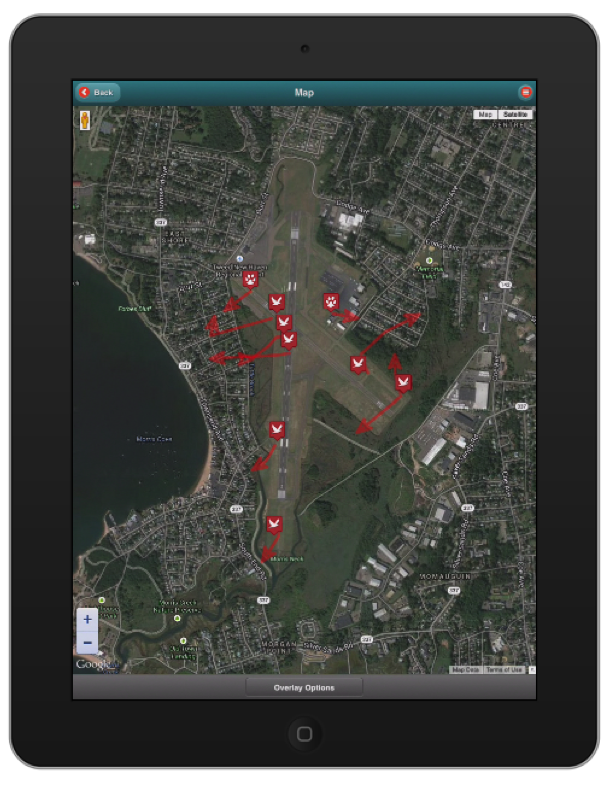I’ve worked with many airports on various projects, and whenever the topic of the Federal Aviation Administration’s Safety Management System (SMS) directive comes up, there is apprehension. While the FAA SMS concept as a whole makes a lot of sense, putting it into practice at first glance looks rather difficult. In reality, though, with the right tools and support, SMS is a no-brainer whose implementation can be much easier than many airport managers may think.
What is SMS, and why is it necessary?
Here’s how a National Academies report sponsored by the FAA describes it:
“Historically, aviation safety has been built upon the reactive analysis of past accidents and the introduction of corrective actions to prevent the recurrence of those events. With today’s extremely low accident rate, it is increasingly difficult to make further improvements to the level of safety by using this approach. Therefore, a proactive approach to managing safety has been developed that concentrates on the control of processes rather than solely relying on inspection and remedial actions on end products. This innovation in aviation system safety is called a Safety Management System (SMS), an expression indicating that safety efforts are most effective when made a fully integrated part of the business operation.” ACRP Report 1, Volume 1
Furthermore, “SMS gives airlines a set of business processes and management tools to examine data gathered from everyday operations, isolate trends that may be precursors to incidents or accidents, take steps to mitigate the risk, and verify the effectiveness of the program…It uses four key components – safety policy, safety risk management, safety assurance, and safety promotion.”
Though it may seem a monumental task to effectively implement SMS, with all the controls, monitoring, alerts, data collection & analysis, and general proactive mindset required, the fact is that the technology to address all SMS requirements exists now. Systems like Veoci are built to address these needs, from the most general to the most specific, from industry-wide best practices to local must-haves to small regional airports & airlines. Though it may sound intimidating (FAA directives always do), with the right software and devices getting SMS up and running is easier done than said.
What does SMS mean, in theory and practice?
Let’s break down the requirements a little further. Essentially the FAA is asking the aviation industry to more effectively modernize safety operations in a number of areas, including a) adoption of enterprise-class tools and methods to collect and analyze data; b) quicker identification of and fixes for vulnerabilities; c) improving existing policies and processes; d) efficient communications and sharing of information; e) fast adaptability to new contingencies and situations.
What this boils down to:
- No more paper! Paper makes it difficult to examine day-to-day operational data or isolate trends. Computers, tablets, and mobile devices make it much easier to input, store, retrieve, and organize data.
- Digitized processes and documentation for a better understanding of situations and easy reference for future planning.
- Identification of risks and implementing processes to mitigate them.
- Properly measuring outcomes and results.

The first and last components of SMS – Safety Policy and Safety Promotion – are documentation, training, and audit functions. They establish your organization’s commitment to safety and document policies, procedures, and processes. We expect these to become boiler-plate with little variation across airports or airlines of similar scale.
Regarding Safety Policy in particular, most airports already have one in place. SMS calls for the documentation and availability of the policy along with documented compliance audits. With today’s technology, these can be implemented rapidly as well and do not require additional resources or time; the added benefit is time saved with on-line rather than paper-based monitoring. One place to start is managing ground vehicle operations training as per FAA Advisory Circular AC No.150/5210-2.
Based on our success working with many airports, we suggest five simple areas for SMS implementation using modern software:
1. Document inspections and maintenance records in an electronic format
As SMS relies heavily on reporting and proactive measures based on the data coming in through that reporting, the first step is to convert all your records into an electronic format to make data management exponentially more efficient. Most airlines and airports have to complete inspections at least twice a day. Typically, these inspections are documented on a standard paper forms. Using software on a mobile device in the field to input these records and remedial work orders reduces errors and also makes it possible to see patterns of breakages and failures and the impetus to find the root cause immediately.
2. Avoid rework – make sure the inspection forms are easily accessible from the field
Electronic forms need to be accessible directly from the field using mobile devices like tablets and smart phones. A lot of time and effort gets wasted when teams have to use a paper form in the field and then come back to the office to input the data and complete a separate electronic version. Also, creating fillable PDF’s is not a good option. Although they are electronic and easy to complete, you cannot generate reports from them.
3. Design forms that generate real-time insights while documenting inspections
Assuming that you have an electronic format for your inspection forms, it is important to ensure that you get proactive insights while filling up a form. For example: The form should show you if there are any existing discrepancies already for a particular inspection item and how many times the problem occurred in the past. For example: While inspecting a component, I should see that this is the third time this component failed in the last 2 weeks.
4. Design reports that prompt and encourage actions
Difficult and cumbersome reports will prevent your staff from using the system in the first place. To illustrate what I mean, let me recount an experience we had helping an airport document wildlife sightings. Each time an animal was spotted, airport staff members would indicate its exact location and direction of movement on a map interface. One day, an operations team member noticed that coyote sightings had increased significantly at a particular location on the airfield – they were able to recognize the pattern simply by looking at the map plotted with all the wildlife incident reports. This led them to further investigate the cause for the increase in sightings, which in turn led them to the discovery of a hole in the fence near the area where coyote sightings were spiking. Having the data immediately presented in a way that allowed team members to identify red flags accelerated repairs to a perimeter fence breach that represented a serious safety risk. Note that this is exactly what SMS is all about – “a proactive approach to managing safety”.

â€
5. Convert SOPs and guidelines into actionable plans
Airports have documented procedures for responses to various incident types. Unfortunately, when incidents unfold, there is little time to run over and open the book and find the appropriate plan. Digitizing plans makes these response plans actionable: with the click of a button, airport and airline managers can send out hundreds of tasks via email, text messages, and phone calls all at once or in pre-defined sequences, to the exact team members, administrators, local authorities and anyone else who needs to know or has to execute an action.
In turn, with the right software loaded onto those team members’ mobile devices and computers, these tasks can also be monitored real-time and provide fuller, faster situational awareness of an incident (Note: Almost 40% of Veoci access is from mobile devices). Preplanned responses on a system like Veoci also make for more realistic and effective drills, and allow people to connect and participate from wherever they may happen to be.
Information management is the key in a Safety Management System implementation, and we are looking forward to working with more airlines and airports this year. The FAA’s directive isn’t a difficult hurdle to overcome, but rather an impetus to improve operations with technology that is available here and today.








